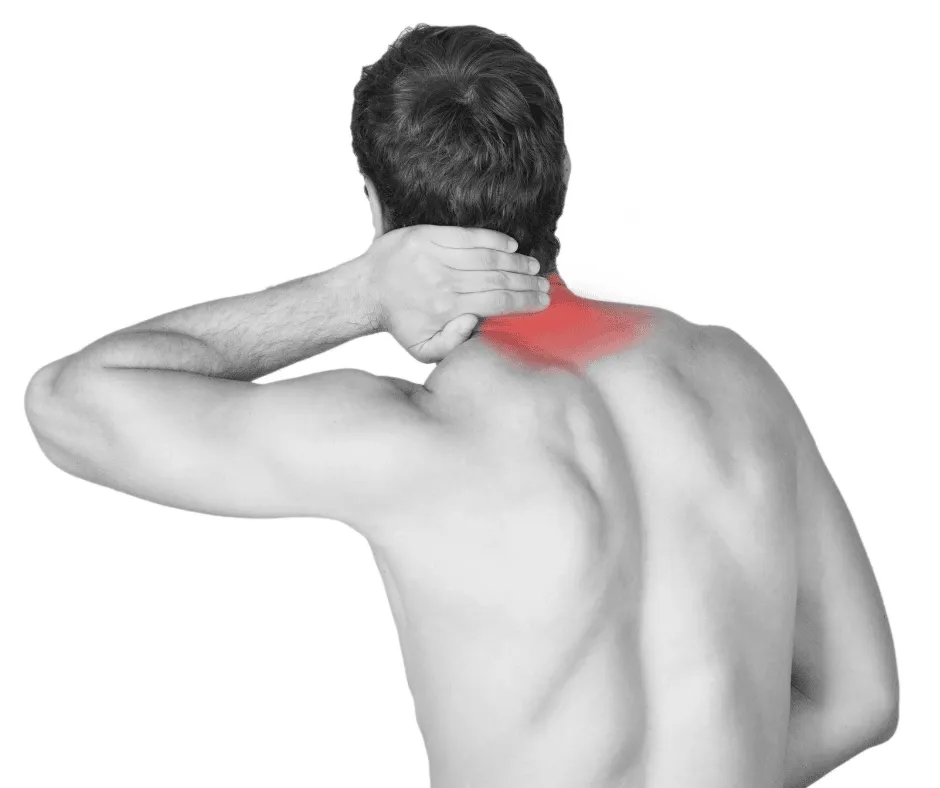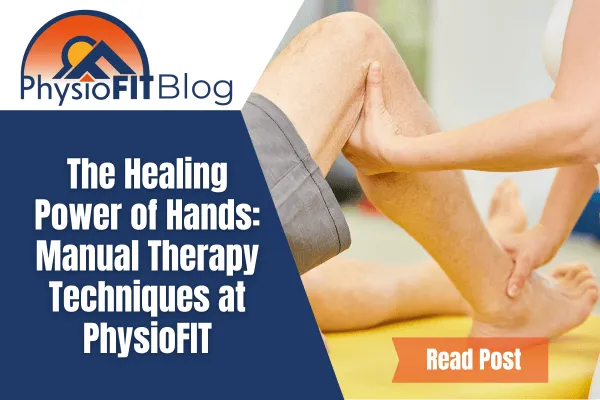Neck Pain Relief
Living Life Shouldn't Be Such a Pain in the Neck
Are you one among the millions experiencing "neck pain" and seeking relief? Neck pain is an everyday battle for roughly 10-20% of U.S. adults, leading to work absences, diminished life quality, and restricted physical activities. Consider us your guide, providing essential knowledge about neck pain and illustrating how we can assist you in restoring your well-being.
At PhysioFit, we are committed to delivering well-rounded neck pain treatments, expertly designed to align with every patient's specific condition and requirements. Our practice is rooted in a science-based, exercise-centric methodology of physical therapy, centered around individualized care plans for pain relief. Our vision transcends the mere alleviation of your neck discomfort; we strive to enhance your holistic health, diminish the chance of chronic or recurrent pain, and expedite your return to your routine activities.
What You Should Know
The most frequent injury resulting from car accidents is neck pain, accounting for nearly half, or 49%, of all vehicular injury cases.
Persistent neck pain may cause an array of complications, including depression, tension in relationships, anxiety, issues at work, hindrance in day-to-day tasks, and excessive tiredness.
Neck discomfort ranks third as a source of chronic pain.
A proper diagnosis of a neck problem involves a thorough evaluation from a professional.

The Most Common Causes of Neck Pain
Neck pain, a common complaint that can arise from various sources, often disturbs the delicate balance of daily life. Whether it's the natural aging process, physical strain, mental stress, traumatic injury, abnormal growths, or an underlying health condition, the origin of neck pain can be multifaceted. Understanding these potential causes is a crucial step towards effective treatment and relief.
Neck discomfort can be attributed to several factors:
Age-related Deterioration: Aging can lead to natural wear and tear of the cervical spine, leading to degenerative conditions like osteoarthritis or spinal stenosis, which can provoke neck pain. Persistent stress and repeated movements can weaken spinal disks, potentially causing a herniated disk or a pinched nerve.
Physical Exertion: Repetitive or strenuous activities can overstrain neck muscles, resulting in stiffness and pain. Factors like poor posture, weak abdominal muscles, and excess body weight can misalign the spine, contributing to neck discomfort. Long hours spent in front of a computer, straining the neck, is a common contributor to neck pain.
Psychological Stress: Stress-induced muscle tightening can lead to neck stiffness and pain. Many individuals may unconsciously tense their neck muscles during periods of stress or agitation, only realizing it when the neck begins to hurt.
Injury: Trauma can damage muscles, ligaments, disks, vertebral joints, and nerve roots in the spinal cord, causing neck pain. Whiplash, a common neck injury resulting from car accidents, often leads to neck discomfort.
Abnormal Growths: Tumors, cysts, and bone spurs can exert pressure on neck nerves, inducing pain.
Underlying Health Conditions: Certain health conditions, including meningitis, rheumatoid arthritis, and cancer, may present neck pain as a symptom.
If any of this information resonates with your current situation, we urge you to schedule an appointment with us immediately. Don't let hip pain diminish your life quality - allow us to help you embark on the path to relief today.
Strategies for Negating Neck Pain
Strategies can be implemented to mitigate neck discomfort related to muscle strain or tension. They are as follows:
Adopt Healthy Posture Habits: Arrange your devices such as computers and phones to prevent neck strain or slouching while using them. Ensure your shoulders are aligned, your back is straight while seated, and your neck isn't strained. Fine-tune your car seats for proper posture during transit.
Optimize Your Sleeping Position: Retain good posture even during sleep. Use a pillow for head support to align your head and neck with your body if you sleep on your side or back. For back sleepers, consider placing a pillow under your knees to lessen lower back pressure. Avoid stomach sleeping with a turned head.
Stay Mobile: Utilize exercises meant for neck pain relief to also prevent it. If your job requires prolonged sitting, incorporate occasional breaks for stretching and mobilizing, including neck muscles.
Avoid Shoulder-Borne Heavy Loads: Refrain from carrying substantial weights like book bags or suitcases on your shoulder. Opt for wheeled luggage or bags instead.
Strengthen Your Upper Back Extensor Muscles: Age-related weakening of the upper back is normal, causing the shoulders to stoop and the head to tilt forward. This posture puts extra strain on your neck and upper back.

Common Symptoms of Neck Pain
Experiencing headaches
Sensation of numbness or a tingling feeling, akin to 'pins and needles', in your shoulders or arms.
Inability to rotate the neck or incline the head
Rigidity in the neck, shoulder, and upper back regions
A radiating pain extending from the neck down to the shoulders or arms
An intense sensation of stabbing or burning
A continuous, nagging discomfort
Remember, if you resonate with any of the symptoms or conditions mentioned, we highly recommend making an appointment with us for a thorough evaluation and personalized treatment plan.
Please Note: The information provided on our website is intended for general education and is not a substitute for professional medical advice. Each individual's situation and body is different. Therefore, what may work for one person may not work for another. We care about your well-being and advise you to reach out to us to discuss your specific needs before implementing any advice from our website.
Your Source for All Things Physical Therapy in Bend Oregon
The PhysioBlog

The Healing Power of Hands: Manual Therapy Techniques at PhysioFIT
Please Note: The information provided on our website is intended for general education and is not a substitute for professional medical advice. Each individual's situation and body are different. Therefore, what may work for one person may not work for another. We care about your well-being and advise you to reach out to us to discuss your specific needs before implementing any advice from our website. If you’d like to explore this more or would like to schedule a time with a physical therapist in Bend Oregon, contact us at PhysioFITBend.com
Introduction
Manual therapy is a key component of PhysioFIT's treatment approach, encompassing a range of specialized techniques to address musculoskeletal issues. This article explores the various manual therapy techniques used by PhysioFIT and other physical therapy professionals and how they can be integrated into treatment plans.
PhysioFIT incorporates a variety of manual therapy techniques, such as joint mobilizations, soft tissue mobilizations, and muscle energy techniques. These hands-on methods are aimed at restoring joint mobility, reducing pain, and improving overall function. By employing precise movements and pressures, manual therapy can target specific areas of the body to alleviate discomfort and promote healing.
In addition to these commonly used techniques, PhysioFIT also utilizes more specialized manual therapy approaches, including myofascial release and trigger point therapy. These techniques focus on releasing tension and addressing specific muscular imbalances that may be contributing to pain or dysfunction. By targeting trigger points and areas of restricted fascia, these techniques can provide significant relief and restore proper muscle function.
One unique aspect of PhysioFIT's manual therapy approach is their emphasis on individualized treatment plans. Each patient's therapy is tailored to their specific needs and goals, ensuring optimal outcomes. This personalized approach allows us to tailor your manual therapy techniques to address the underlying cause of the patient's condition, rather than just treating the symptoms.
Joint mobilization
Joint mobilization is a therapeutic technique used to improve joint movement and function. PhysioFIT incorporates various methods that promote joint mobilization, such as manual therapy techniques that focus on gentle and controlled movements. These techniques aim to reduce pain, increase joint flexibility, and enhance overall joint health. By applying specific forces to the joint, joint mobilization aids in restoring proper alignment and promoting tissue healing. This approach is particularly effective for individuals with restricted joint motion or conditions such as arthritis. Additionally, incorporating joint mobilization techniques into a comprehensive treatment plan can lead to improved mobility and quality of life for patients.
In the context of joint mobilization, it’s important to note that a thorough assessment is essential to determine the most appropriate technique for each individual. Factors such as the patient's age, level of joint dysfunction, and overall health should be considered when selecting the most suitable approach. The physiotherapist will apply gentle and precise pressure to the joint, targeting specific areas to achieve the desired outcome. This technique requires specialized training and expertise to ensure safety and effectiveness.
One unique aspect of joint mobilization is its ability to not only target the joint itself but also the surrounding soft tissues. By incorporating mobilization techniques that address both the joint and surrounding muscles, ligaments, and tendons, a comprehensive approach to rehabilitation can be achieved. This approach aims to restore proper balance, stability, and function to the entire joint complex.
Soft tissue mobilization
Soft tissue manipulation is a technique used in manual therapy to mobilize and manipulate soft tissues, such as muscles, tendons, and fascia, to improve mobility and reduce pain. PhysioFIT incorporates various soft tissue mobilization techniques to help clients recover from injuries and improve their overall musculoskeletal health. These techniques may include deep tissue massage, myofascial release, and instrument-assisted soft tissue mobilization.
By targeting specific areas of dysfunction and tension, soft tissue mobilization can help alleviate pain, improve range of motion, and enhance tissue healing. Regular sessions of soft tissue mobilization can be beneficial for athletes, individuals with chronic pain conditions, and those recovering from surgery or injury.
Strain-Counterstrain Therapy
Strain-counterstrain therapy, a popular manual therapy technique used at PhysioFIT, involves the passive positioning of a patient to relieve pain and tension. This method differs from others as it aims to soften and reset targeted muscles and joints, promoting healing and optimizing function.
By applying gentle pressure to specific tender points and then passively moving the patient, strain-counterstrain therapy allows the body to reset muscle tension and decrease pain. This technique works by activating the proprioceptive system, which helps the body recognize and correct imbalances, promoting a healthier musculoskeletal system.
What sets strain-counterstrain therapy apart is its focus on finding tender points throughout the body, including muscles, tendons, and ligaments. This method aims to address restrictions and imbalances at their source, providing targeted relief and improved range of motion.
Incorporating strain-counterstrain therapy into your treatment plan can bring several benefits. Firstly, it helps to relax and release tense muscles, promoting pain relief and improved function. Additionally, this technique can enhance joint mobility and stability, reducing the risk of future injuries. By improving the body's proprioceptive system, strain-counterstrain therapy provides long-term benefits and helps patients achieve optimal physical well-being.
Myofascial release
Myofascial therapy is a specialized technique used by physiotherapists to address myofascial restrictions and promote healing. PhysioFIT incorporates various approaches to myofascial release, such as deep tissue massage, trigger point therapy, and stretching exercises. These techniques aim to relieve pain and improve range of motion by targeting the fascia, a connective tissue that surrounds muscles and organs.
By applying sustained pressure and stretching to the affected area, myofascial therapy helps to release tension and restore proper function. PhysioFIT tailors each session to the individual's specific needs, ensuring a personalized approach to myofascial release. This therapy can be particularly beneficial for individuals with chronic pain, postural imbalances, or sports-related injuries.
In addition to the traditional hands-on techniques, PhysioFIT also incorporates advanced tools like foam rollers and myofascial release balls to enhance the effectiveness of myofascial therapy. These tools can provide targeted pressure to specific areas, allowing for self-treatment and maintenance between sessions.
Myofascial release has been proven to be an effective technique for pain management and rehabilitation. A study published in the Journal of Manipulative and Physiological Therapeutics found that myofascial release significantly improved pain and function in patients with chronic low back pain.
Instrument-Assisted Soft Tissue Mobilization
Instrument-assisted soft tissue mobilization (IASTM) is a technique used by physiotherapists to treat various musculoskeletal conditions. Here are 5 key points about IASTM:
IASTM involves using specially designed instruments to detect and treat areas of soft tissue dysfunction.
It helps to break down adhesions, scar tissue, and fascial restrictions in the muscles and soft tissues.
By applying controlled pressure and friction, IASTM promotes the healing process and improves blood circulation.
IASTM can be used to alleviate pain, increase range of motion, and restore joint function.
This technique is often combined with other manual therapy techniques and exercises for optimal results.
One unique aspect of IASTM is its ability to target specific areas of soft tissue dysfunction, allowing for precise treatment. It is a non-invasive approach that can be effective in reducing pain and improving functional outcomes.
Active Release Techniques
Active Release Techniques (ART) are a set of manual therapy techniques used by physiotherapists to treat soft tissue injuries and muscle imbalances. These techniques involve the skilled manipulation and release of tight and tender muscles, tendons, ligaments, and fascia.
ART involves the practitioner using their hands to apply targeted pressure on specific areas of the body, while the patient actively moves the affected joint or muscle through a range of motion.
By combining precise tension and movement, ART helps to break down scar tissue, release adhesions, and restore normal function to the soft tissues.
ART has been shown to be effective in reducing pain, improving flexibility and mobility, and enhancing athletic performance.
ART is a valuable addition to physiotherapy because it not only treats the symptoms but also addresses the underlying cause of the injury. By targeting specific areas of dysfunction, ART helps to restore proper muscle balance, improve joint mechanics, and optimize movement patterns. This holistic approach ensures long-lasting results and reduces the risk of future injuries.
Conclusion
Physical therapy techniques are an essential part of manual therapy practiced at PhysioFIT. These techniques are explored and incorporated effectively to ensure optimal outcomes for patients. By using a variety of manual therapy techniques, such as joint mobilization, soft tissue mobilization, and muscle energy techniques, PhysioFIT aims to provide comprehensive and personalized care to address individual needs and promote recovery. Implementing evidence-based practices and staying up-to-date with the latest research in manual therapy allows PhysioFIT to deliver high-quality treatment and better outcomes for their patients. The focus on incorporating different manual therapy techniques sets PhysioFIT apart and enables them to provide a holistic approach to rehabilitation and physical well-being.
In addition to their comprehensive approach to manual therapy, PhysioFIT also emphasizes the importance of patient education and empowerment. By educating patients about their condition and the benefits of manual therapy, they can actively participate in their treatment and recovery process. This patient-centered approach not only helps patients achieve better outcomes but also enables them to take control of their health and well-being in the long term.
To experience the benefits of PhysioFIT's comprehensive manual therapy, schedule an appointment today. Don't miss out on the opportunity to enhance your well-being and successfully recover from injury or health condition. Your journey towards optimal physical health begins with PhysioFIT.
FAQ
What is manual therapy?
Manual therapy is a type of physical therapy where a therapist applies pressure on bones and soft tissues to relieve tension, decrease pain, and mobilize joints and muscles. It can also help restore function in certain body parts after an injury. Some techniques involve the use of hands, while others use instruments.
What are the benefits of manual therapy?
Manual therapy techniques have several benefits, including relieving tension, decreasing pain, improving joint mobility, increasing range of motion, reducing inflammation, improving flexibility, and restoring mobility in joints that have lost it. It can also be effective in treating conditions like golfer's elbow, tendinitis, back pain, and sciatica.
What is joint mobilization?
Joint mobilization is a manual therapy technique where a therapist manually applies pressure to a joint to improve its mobility and range of motion. It is beneficial for patients experiencing stiffness or pain in their joints, such as those with golfer's elbow or tendinitis in their shoulder.
What is soft tissue mobilization?
Soft tissue mobilization is a manual therapy technique where a therapist stretches and applies pressure to muscles and ligaments. This technique breaks up muscle tissue, relieving tension and reducing inflammation. It also helps improve flexibility and restore mobility in joints.
What is strain-counterstrain therapy?
Strain-counterstrain therapy, also known as positional release therapy, is a gentle technique where a therapist holds your body in specific positions for intervals of 90 seconds. This therapy allows the sensory receptors within the muscles to relax in a comfortable and natural position, effectively relieving tension in the muscles.
What is myofascial release?
Myofascial release therapy is a manual therapy technique that targets the fascia, the thick tissue that coats bones and muscles in our body. The therapist manually manipulates stiff or tight spots in the fascia to restore pliability, relieving pressure on the joints and muscles. It is commonly used to treat back pain, sciatica, and other forms of chronic pain.
Please Note: It's important to note that any exercises or techniques that are shared should be performed under the guidance of a qualified bend physical therapy expert to ensure correct technique and to prevent injuries. A physical therapist can provide a customized exercise program based on the individual's fitness level, goals, and any existing injuries or conditions. If you’d like to explore this more or would like to schedule a time with a physical therapist in Bend Oregon, contact us atPhysioFITBend.com
Copyright PhysioFIT 2025 . All rights reserved


